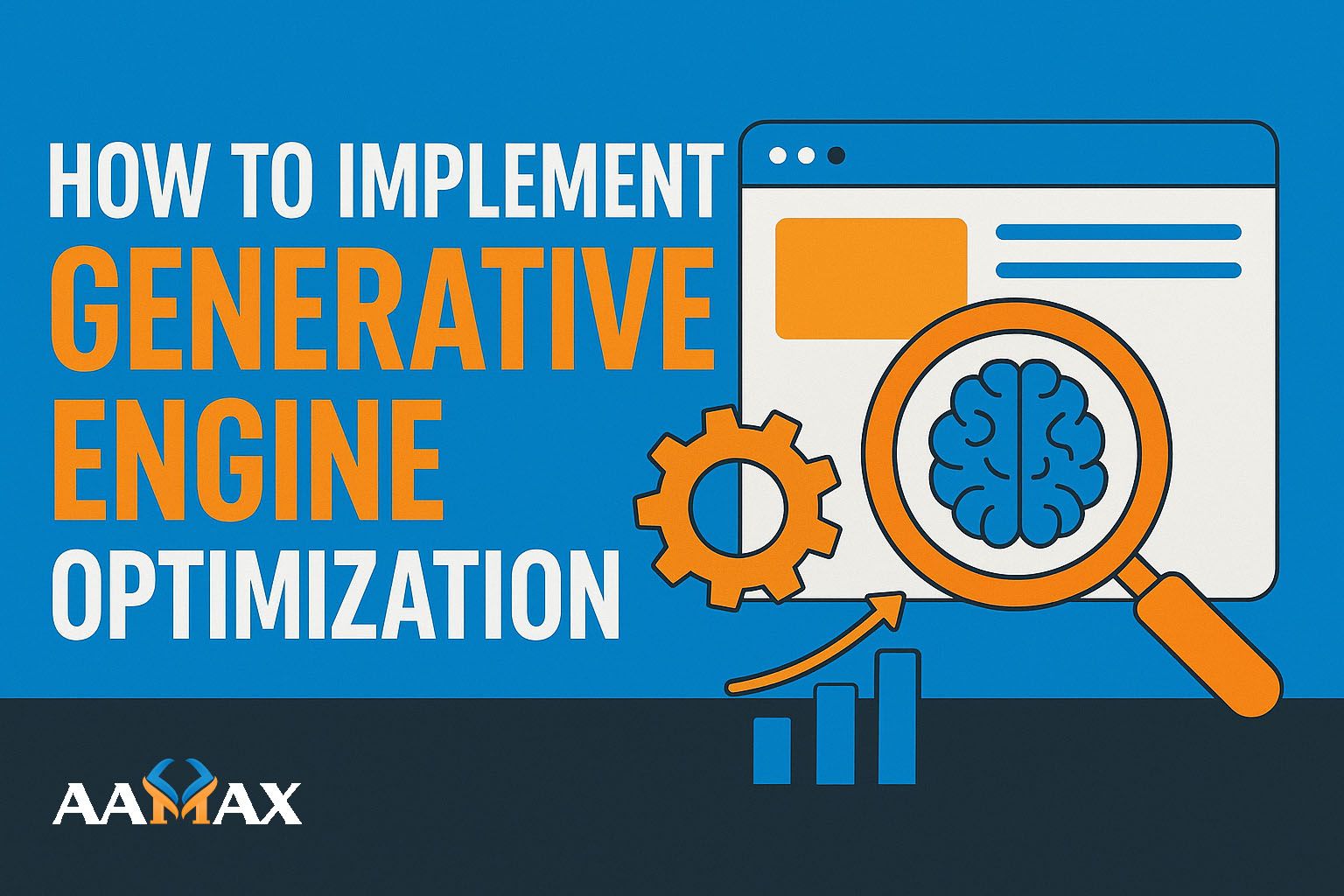
How To Implement Generative Engine Optimization
The way people find information online is changing rapidly. With the rise of Generative AI engines such as ChatGPT, Google Gemini, and Perplexity, the traditional search model is being replaced by AI-driven systems that generate direct, conversational answers instead of just displaying a list of links. This shift has given birth to a new digital marketing discipline known as Generative Engine Optimization (GEO).
In this guide, we’ll explore how to implement Generative Engine Optimization step-by-step so your website and brand can stay visible in the AI-powered search era. Whether you’re an e-commerce store, a service provider, or a content publisher, understanding how GEO works and how to implement it will be essential for maintaining your online presence.
What Is Generative Engine Optimization?
Generative Engine Optimization (GEO) is the process of optimizing your website and content so that AI-powered generative engines can easily interpret, summarize, and feature it within their generated responses.
Unlike traditional SEO (Search Engine Optimization), which focuses on ranking web pages in search engine results, GEO focuses on making your information discoverable and usable by generative models that synthesize information to answer user questions.
For example, when a user asks, “What’s the best phone under $500 in 2025?”, a generative engine might create a full response listing recommended models, their specs, and short descriptions. With effective GEO, your product or brand could be included in that AI-generated answer.
Why Implement Generative Engine Optimization Now?
Generative engines are becoming an integral part of how users interact with digital information. The number of people using AI chat interfaces for product research, education, and recommendations is increasing daily.
Implementing GEO helps you:
- Stay visible as generative search becomes mainstream.
- Build authority and trust with AI-driven platforms.
- Improve content discoverability across multiple AI systems.
- Future-proof your SEO strategy as traditional search evolves.
Simply put, GEO is not replacing SEO — it’s the next evolution of it.
Step-by-Step Guide: How To Implement Generative Engine Optimization
Implementing GEO requires combining traditional SEO fundamentals with AI-oriented strategies. Below is a detailed, step-by-step process to help you successfully apply Generative Engine Optimization to your website.
Step 1: Conduct a GEO Readiness Audit
Before implementing GEO, you must understand where your website currently stands. A GEO readiness audit involves assessing your content, structure, and authority to determine how well AI systems can interpret your data.
Your audit should include:
- Reviewing existing structured data (schemas, metadata).
- Evaluating content clarity and factual depth.
- Checking for consistent brand and product information across platforms.
- Identifying gaps in conversational and question-based content.
- Analyzing backlinks and domain trustworthiness.
Use AI tools, SEO software, and structured data validators to assess these areas. The audit will serve as the foundation for your GEO strategy.
Step 2: Optimize Content for AI Readability
Generative AI models rely on contextual understanding, not just keywords. They analyze your content to extract meaning and deliver coherent responses. To make your content AI-readable:
- Use natural language: Write in a conversational tone that reflects how real users ask questions.
- Answer specific queries: Include FAQ sections and user-focused questions like “What is the best option for…” or “How can I use this product for…”
- Expand context: Explain not just what something is, but how and why it matters.
- Provide value-rich details: Generative engines reward completeness. Cover product specifications, benefits, use cases, and comparisons.
- Avoid fluff and repetition: AI systems prefer clarity and structure over keyword stuffing.
Think of your content as data for AI — the clearer it is, the better it will perform in generative searches.
Step 3: Implement Structured Data and Schema Markup
Structured data is the backbone of Generative Engine Optimization. It helps AI systems understand your content semantically — meaning they know what your content represents rather than just the words used.
To optimize for GEO, use Schema.org markup on your website:
- Product Schema: Define product name, price, brand, availability, and reviews.
- FAQ Schema: Include frequently asked questions to answer user intent directly.
- Article Schema: Provide author, publish date, and metadata for blog posts.
- Organization Schema: Add company name, logo, contact info, and social profiles.
- Review Schema: Showcase customer ratings and feedback for credibility.
You can validate structured data using Google’s Rich Results Test or Schema.org validators. Proper schema markup increases your content’s chance of being selected and cited by generative engines.
Step 4: Strengthen E-E-A-T (Experience, Expertise, Authoritativeness, Trustworthiness)
Generative engines prioritize trustworthy and authoritative sources. This aligns with Google’s E-E-A-T principle — Experience, Expertise, Authoritativeness, and Trustworthiness.
Here’s how to strengthen E-E-A-T:
- Experience: Include real-world examples, case studies, or customer success stories.
- Expertise: Showcase author credentials and link to relevant expertise pages.
- Authoritativeness: Get mentions and backlinks from reputable industry websites.
- Trustworthiness: Use HTTPS, display contact information, and maintain transparency.
AI engines analyze these factors to determine if your website’s information is reliable enough to use in generated answers.
Step 5: Create Conversational and Contextual Content
Generative engines interpret user intent in a natural, conversational way. To align with this, your content should be structured to mimic human conversations.
Here’s how:
- Use question-based headings (e.g., “How does this product work?” or “Why is this service important?”).
- Include semantic variations of your keywords that reflect real-world phrasing.
- Add summary sections that answer key questions directly.
- Focus on intent-based optimization instead of keyword density.
Generative AI models also favor content clusters — interconnected pages around one topic. Create topic clusters where one main page links to related subtopics for depth and context.
Step 6: Optimize Multimedia for Multimodal AI
Generative engines are becoming multimodal, meaning they process text, images, videos, and even audio. Optimizing multimedia elements ensures your content remains visible across formats.
Steps to take:
- Use descriptive alt text for images, focusing on context and details.
- Add transcripts and captions for videos.
- Include descriptive filenames and metadata for media assets.
- Ensure visual content complements textual explanations.
AI systems like Gemini can interpret images as part of their reasoning process, so providing context through metadata and captions increases discoverability.
Step 7: Maintain Data Consistency Across Platforms
Generative engines source data from multiple platforms — your website, social media, review sites, and marketplaces. Inconsistent information confuses AI systems and reduces credibility.
To fix this:
- Keep product details, pricing, and specifications consistent everywhere.
- Use the same business name, address, and contact details across all listings.
- Regularly update outdated information.
Consistency signals trustworthiness to both users and AI systems, improving your brand’s chance of inclusion in generative responses.
Step 8: Build Authority Through Backlinks and Mentions
Backlinks remain a vital signal — not for ranking, but for authority recognition. AI models interpret backlinks and brand mentions as credibility markers.
How to build GEO-friendly authority:
- Contribute guest posts to industry publications.
- Get listed in reputable directories and comparison sites.
- Encourage social mentions and citations.
- Collaborate with influencers and thought leaders.
These efforts amplify your digital footprint and improve the likelihood that your content will be surfaced by AI-powered engines.
Step 9: Leverage AI Analytics and Tracking
Measuring GEO performance differs from traditional SEO tracking. Instead of rankings, you’ll want to monitor how your brand appears in AI-generated content.
You can track:
- Mentions of your brand or products in AI responses.
- Referral traffic from AI-powered platforms.
- Engagement metrics for content structured for AI discoverability.
- Schema markup validation and indexing rates.
As tools for tracking GEO visibility evolve, staying proactive will give you a significant edge.
Step 10: Regularly Update and Train Content for AI Evolution
Generative AI models are constantly learning from new data. To remain relevant, your content must evolve with them.
You can:
- Refresh old content with new data, examples, and insights.
- Update structured data as standards change.
- Add FAQs based on emerging search trends.
- Monitor updates to AI systems like ChatGPT, Gemini, or Claude.
Consistent updates signal freshness and reliability, both of which are key ranking factors for generative engines.
Common Mistakes to Avoid in GEO Implementation
While implementing Generative Engine Optimization, many businesses fall into common traps that reduce their effectiveness:
- Keyword stuffing instead of focusing on intent and clarity.
- Neglecting structured data, making content harder for AI to interpret.
- Ignoring multimedia optimization, missing multimodal opportunities.
- Over-automation, leading to thin, repetitive, or inaccurate content.
- Failing to monitor visibility, resulting in outdated strategies.
Avoid these pitfalls by prioritizing user value and factual accuracy over quick SEO hacks.
The Future of GEO Implementation
As AI continues to evolve, Generative Engine Optimization will expand to include new technologies like voice interfaces, augmented reality, and AI-driven personalization. In the future:
- Content will adapt dynamically to user context.
- AI will favor websites with real-time structured data.
- Multimedia and conversational formats will dominate digital discovery.
Implementing GEO today puts you ahead of competitors who are still optimizing solely for traditional search.
Partner With Experts to Implement GEO Effectively
Implementing Generative Engine Optimization requires a blend of technical SEO, data structuring, and strategic content development. If you want expert guidance, consider hiring AAMAX — a full-service digital marketing company offering Web Development, Digital Marketing, and SEO Services. Their experienced team can help you build a data-driven GEO strategy that ensures your website is ready for the AI-powered future of search.
Conclusion
Generative Engine Optimization represents the next phase of digital visibility. It’s about helping AI systems understand, trust, and feature your content in the answers they generate.
By combining structured data, conversational content, multimedia optimization, and consistent branding, you can make your website a trusted source for generative AI engines.
The sooner you start implementing GEO, the stronger your position will be in the evolving world of AI-driven discovery. Future-proof your business today by adapting to the way information is being found — not through links, but through intelligence.







